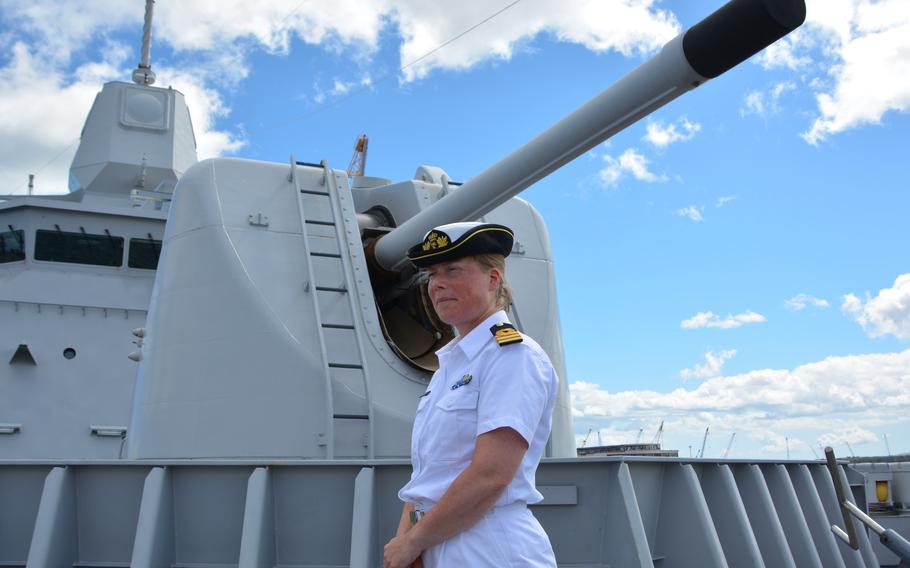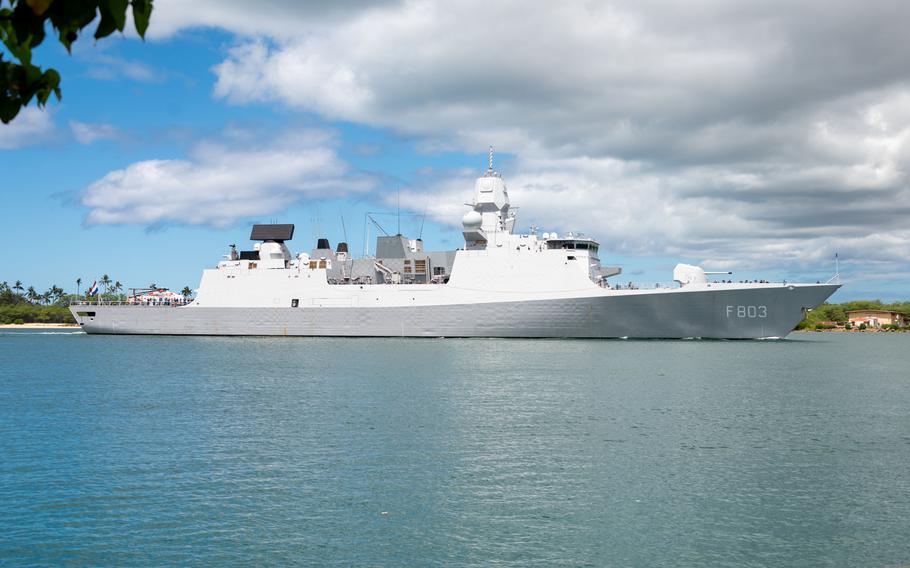
Cmdr. Yvonne van Beusekom, commander of the Royal Netherlands Navy frigate HNLMS Tromp, stands beside a 127-mm cannon on the ship’s bow while talking with reporters on June 28, 2024, at Joint Base Pearl Harbor-Hickam, Hawaii. (Wyatt Olson/Stars and Stripes)
JOINT BASE PEARL HARBOR-HICKAM, Hawaii — Personnel and ships from navies across the Pacific sail into Hawaii every two years for the Rim of the Pacific exercise, but some participants come from much farther away.
“The Netherlands is almost literally on the other side of the world, so it’s very precious for us to be here,” Cmdr. Yvonne van Beusekom, commander of the HNLMS Tromp told reporters Friday from the bow of the frigate docked at Joint Base Pearl Harbor-Hickam.
It is the first time a ship from the Netherlands, a European nation that borders the North Sea and lies directly across from Great Britain, has joined the drills.
Two of its European neighbors, Belgium and Germany, are also at RIMPAC, which runs through Aug. 1.
Israel, another notably non-Pacific nation, is also among the 29 participating countries.
The U.S. Navy touts RIMPAC as the world’s largest maritime exercise, and it focuses primarily on developing relationships among the participants and improving their ability to work together in the event of disaster or warfare in the Pacific.
But the benefits go beyond region and thus draws navies from across the globe, U.S. Navy Vice Adm. John Wade, commander of this year’s RIMPAC, said during a news conference Thursday.
“Look, we live in an interconnected world, and what is happening in one area of the world also impacts another,” said Wade, who also commands the San Diego-based 3rd Fleet. “And it’s clear, at least to me and my senior leadership, that global security and our future prosperity is absolutely linked to the Indo-Pacific region.”
About 80% of the world’s trade by volume flows through the Indo-Pacific, he said.
China is involved in producing and shipping a great deal of that trade, but Beijing has at the same time grown more strident in its goal of dominating the region not just economically but militarily.
“So, peace and stability in the Indo-Pacific is so vitally important,” Wade said. “Even though there are nations that are not in the Pacific, per se, their interests do apply to the Pacific, and I would highlight that that is why they are participating.”
Rear Adm. Kazushi Yokota of the Japan Maritime Self-Defense Force, the exercise’s vice commander, shortened that thought to a familiar phrase.
“Free and open oceans are critically important to every country in the world,” Yokota said.
Van Beusekom reminded listeners that the Netherlands is a trading country.
“Much of our trade goes to and from Asia so it’s a vitally important area for us. Being able to train with countries, with the different navies, is very important to us to enhance our cooperation and improve the stability of the region.”

Royal Netherlands Navy frigate HNLMS Tromp arrives at Joint Base Pearl Harbor-Hickam, Hawaii, June 26, 2024, for the Rim of the Pacific exercise. (Sarah Eaton/U.S. Navy)
The HNLMS Tromp, a 475-foot-long air defense and command frigate with a vertical missile launching system, arrived in Hawaii on Wednesday.
That was roughly the halfway mark in the ship’s six-month worldwide deployment that took it through the Mediterranean Sea, Red Sea, East China Sea, Taiwan Strait and South China Sea.
After RIMPAC, it will traverse the Panama Canal, visit the Caribbean and then return home, van Beusekom said.
The frigate came to the Pacific to support the United Nations coalition that oversees enforcement of maritime sanctions against North Korea, she said.
The frigate, which carries a crew of about 200 for the global deployment, conducted maritime operations in May in the South China Sea with the U.S. Navy littoral combat ship USS Mobile and dry cargo ship USNS Wally Schirra.
“While traveling over here … we have visited several ports and seen how important this region is,” van Beusekom said.
An incident with a Chinese aircraft in the East China Sea also gave the crew a better understanding of the challenges in maintaining freedom of navigation in the region.
While in those waters during the UN mission, a Chinese People’s Liberation Army helicopter approached the ship’s helicopter crew, van Beusekom said.
“It was potentially unsafe,” she said. “The helicopter was very close, but we were able to continue the mission.”